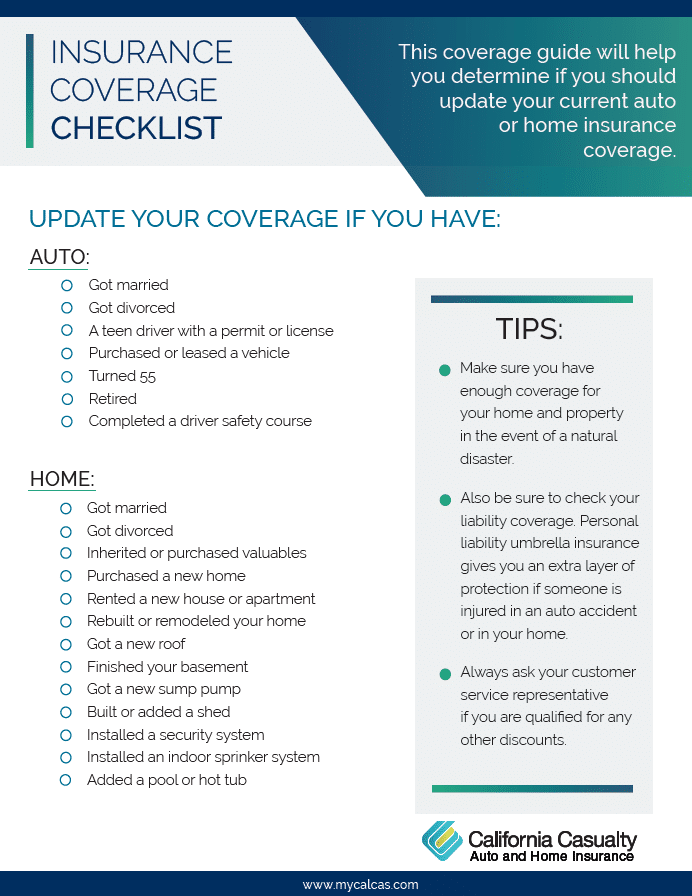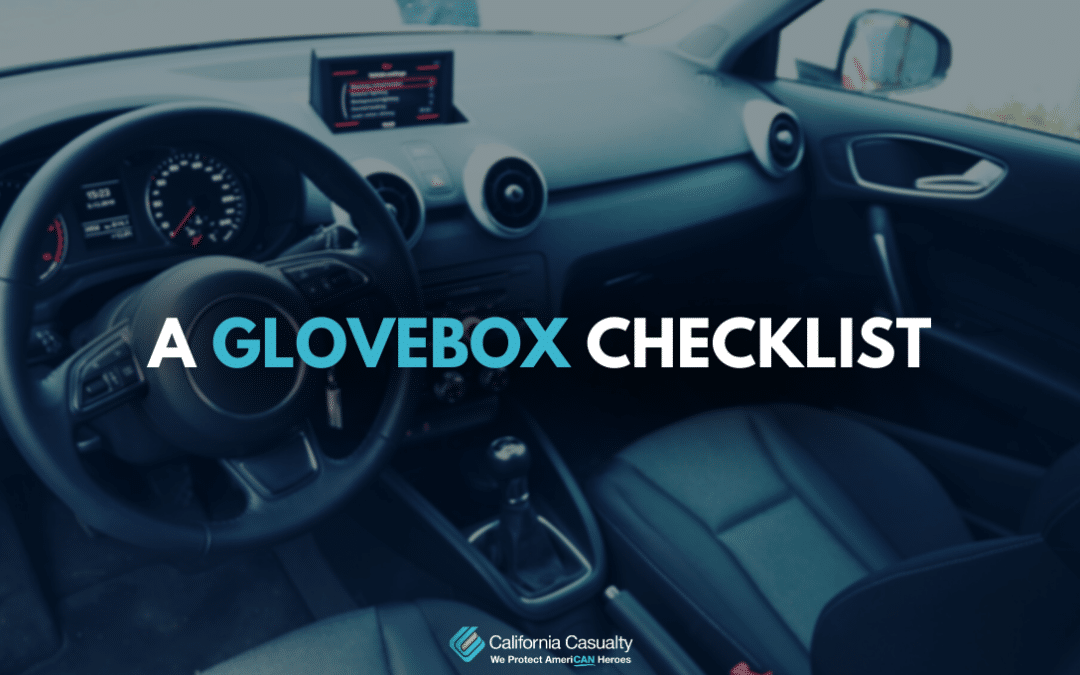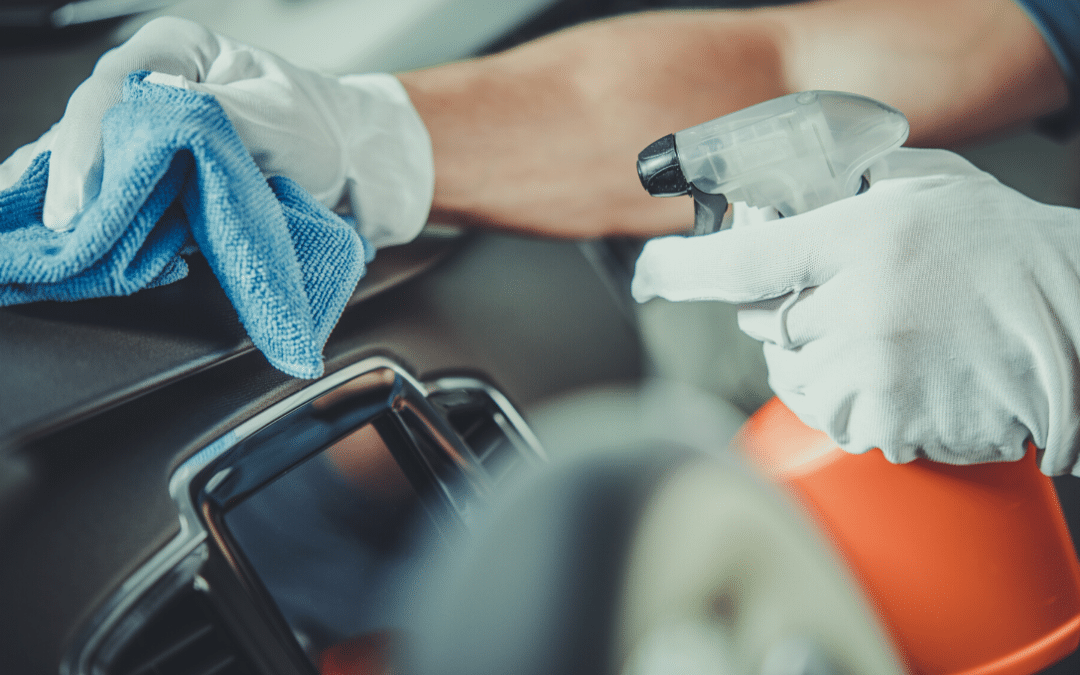
by California Casualty | Auto Insurance Info, Safety |
Whether summer road trips beckon or you’re resuming more pre-quarantine activities, increased highway time with your tiny-passenger crew means revisiting best practices for safety.
Check out the following tips for keeping kids safe while in your ride. We’ve also gathered some strategies for keeping your car’s interior safe (and clean) from those same tiny passengers.
The Safety Basics
-
- Always use a car seat. Car seats are designed to protect children from injury or death during vehicle collisions, so choosing the right one and installing it properly tops the list. Check the car seat laws in your state here, and refer to the National Highway Traffic Safety Administration for an in-depth guide on car seats and booster seats.
- Activate child locks to prevent any dangerous mishaps with children accidentally opening doors.
- Use the window locks to keep children from playing with the controls and potentially getting their hand, arm or hair caught in a rolling window.
- Secure safety belts. If there are any unused, loose belts within arm’s reach of your child, secure them so there’s no chance of them becoming an entanglement hazard.
- Never leave a child alone in a car. Not even for a minute. From heat stroke and abduction risk to the possibility of a hit-and-run incident or your child getting loose in the car, the potential of harm is simply too great to chance it.
- Never leave your keys in the ignition or car. Ever-observant, your children have surely seen how you use your keys and, if afforded the chance, could try mimicking your actions.
- Use the back-up camera to avoid hitting children outside your vehicle who may be out of view.
More Child-Proofing
-
- Declutter the car. Any object can become a projectile in an accident, so make sure items are secure or stowed away. Keeping your car clean also decreases the risk of your child grabbing something that might be a choking hazard.
- Use sunshades to protect their delicate skin from harsh UV rays. You can find easy-to-use shades in a variety of shapes, sizes, and styles.
- In-car entertainment. The upside to living in the Age of Screens is that they’re a parent’s best friend in keeping kids distracted and entertained in the car.
- Never drive distracted. Not only does distracted driving endanger you and your children, it sets a bad example for their future driving habits. Eating, texting, inattention, and daydreaming all pull your focus away from the road. So does engaging with your kids in the back seat, which is all the more reason to get everyone set up and settled in before you pull out from the driveway.
- Maintain your vehicle to decrease the chances of overheating, breaking down or getting stranded.
Minimizing the “Mess Orbit” in Your Car
-
- Get a rug or a beach towel to protect underneath the car seat and along the entire seat’s length. It’s easy to remove, shake out, and throw in the washer.
- If you allow food in the car, only allow that which can be vacuumed up (i.e. nothing squishy, mushy or sticky). For liquids, water (in spill-proof cups) tops the list for easiest clean-up.
- Cover the backs of the driver and front passenger seats to protect them from dirty footprints.
- Put cupcake liners in the cupholders to catch those unreachable crumbs.
- Invest in a quality seat protector for leather seats that may become stressed by the car seat’s weight over time.
As with anything else that involves kids, creating habits and routines are often the key to success. When it comes to vehicle safety, adopting best-practice habits will keep your entire crew safer and happier on the road.
This article is furnished by California Casualty, providing auto and home insurance to educators, law enforcement officers, firefighters, and nurses. Get a quote at 1.866.704.8614 or www.calcas.com.

by California Casualty | Auto Insurance Info, Homeowners Insurance Info |
Although it is recommended to review your home and auto insurance policies yearly, 60% of all Americans are underinsured and/or don’t understand their policies. Do you know what’s really covered with your insurance policy?
If you don’t or you have any doubts, now is a great time to get an annual review of your auto and home/renters insurance policies. You’ll sleep better at night knowing you are protected against expected surprises if you have a claim. You may also find you are eligible for additional savings and discounts!
Here are seven examples of why you should contact your insurance advisor to review your policy:
- You got married. Newlyweds often pay less for insurance than when they were single. You can also find discounts by combining your autos with one insurance company. It also means all those expensive wedding gifts you received might need extra protection.
- You got divorced. You probably are no longer sharing a vehicle and moved into a different residence. You’ll need to inform your insurance company to set up separate auto and home or renters insurance policies.
- Your teen got a driver’s permit or license. You need to let your insurance company know if they are driving your vehicles, or if you bought them one. Make sure that you take advantage of good student discounts and additional multi-vehicle savings!
- You bought or inherited valuables such as antiques, fine art, jewelry or other collectibles. Your standard homeowners or renters insurance policy provides limited coverage of high dollar items. This is a good time to purchase scheduled personal property endorsements to cover your new valuable possessions for a higher amount.
- You’ve added on to your home or have remodeled. Improvements to your house mean there is more to protect. Contacting your insurance company is a good way to make sure that you have enough coverage. This also applies for a new gazebo, shed or pool, or hot tub.
- You’ve moved to a flood or earthquake prone area. Neither earthquake nor flood insurance is included with most homeowners or renters policies. You need to purchase separate flood or earthquake insurance. Keep in mind that flood insurance has a 30-day waiting period before it becomes effective.
- You’ve retired. This often means you are driving less, which could significantly reduce your insurance costs. Drivers over 55 also often get discounts from their insurance companies and you can further reduce your premiums by completing a driver safety course.
Knowing more about your insurance could save you money on your premiums and heartache in the event of a break-in or natural disaster.
If it is time for your auto or home insurance coverage review contact one of our customer care advisors today at 1.800.800.9410. A few minutes of your time will provide the appropriate protection, and we may even find you some extra savings!
If you don’t know where to start to determine if it’s time for your policy review, download our free Insurance Coverage Checklist. Just click the image below for your free download!

by California Casualty | Auto Insurance Info, News |
We have amazing employees at California Casualty. The Employee Spotlight is a new series aiming to highlight those talented individuals that make up our successful company culture and community. From human resource recruiters and learning and development trainers to claims adjusters, marketers, customer support specialists, partner relations, sales representatives, and beyond; each week, we’ll highlight a new team member, so you can get to know us better and see how our employees make us who we are as a company.
This edition of the Employee Spotlight will feature our Inbound Sales Representative, Kevin DeSousa
Kevin is a newer employee at CalCas, he’s almost been with us for a year and is based in our Colorado office.
Let’s get to learn Kevin!

What made you want to work as a Sales Representative at California Casualty?
I really just enjoy talking to people. It feels great when you’re also assisting a customer with a necessity such as insurance.
What is your favorite part about your job?
Besides knowing that we’re helping our teachers, law enforcement officers, firefighters, and nurses! I enjoy really getting to know our customers, I talk to each person on the phone like I’m talking to one of my family members. I don’t want to under-insure my family and I also don’t want to over-insure my family; I want to make sure that everyone is paying for what they need to help take the best care of themselves as possible.
What have you learned in your position at California Casualty?
I have learned so much. Since getting hired on, I have a completely newfound respect for the insurance industry. Before it was just thinking that my car/house is covered from damage if something were to happen. But now, it’s much more than that, knowing what all the numbers mean and why certain people need certain coverages -not everyone needs the same coverage. Literally, within my first month here, I went home and redid my own insurance and made sure that I was covered correctly.
What are your favorite activities to do outside of the office?
I enjoy my family and my church family. Anytime we can all get together that is a good day!
I love going camping and enjoying the wilderness, I would say I go fishing, but I have yet to catch anything this season, so we’ll just skip that….
I have also enjoy working on updating my house and working in my yard with my small farm.
Anything else you would like the audience to know about you?
Been married 10yrs in August; we have an 8-year-old boy and a 4-year-old girl.
I am originally from New Hampshire and a HUGE Patriots Fan
I own a lot of animals on my small farm I have: 2 Dogs (1 Grand Pyrenees and 1 Husky), 7 Chickens, 3 Ducks, 1 Bearded Dragon, 2 Hermit Crabs, and 2 Guinea Pigs.
I am 100% Portuguese; for my childhood summer vacation most kids would go to Disney; I would go to the Azores and I LOVED it.
If you want to learn more about Kevin or are interested in a career at California Casualty, connect with him on LinkedIn! Or visit our careers page at https://www.calcas.com/careers

by California Casualty | Auto Insurance Info |
Our streets and freeways are coming back to life after having been empty for months. Now that we’re all getting back on the road, we’re getting re-acquainted with driving etiquette, traffic laws and sharing space with other drivers . . . which makes this a great time for a safe-driving refresh.
Here are 10 top driving errors and how you can easily correct them.
- Incorrect Speed
DON’T: drive too fast or too slow. Drivers often go faster than the posted speed limit (which is incredibly dangerous near schools and in residential areas) or drive too fast in extreme weather conditions or congested traffic. On the flip side, driving well below the speed limit can cause unsafe conditions for you or other drivers.
How to Correct: Make sure to abide by speed limits and also adjust speed according to your specific environmental conditions.
- Improper Lane Changes
DON’T: make unsafe lane changes. Changing lanes without double-checking for other vehicles can often lead to disastrous results. Blind spots, speed, and distraction all increase the risk of a collision.
How to Correct: Make it a habit to check mirrors, use turn signals, and do a full head check before changing lanes.
- Following Too Closely
DON’T: tailgate other cars. In the event of a stop or crash, there is not enough reaction time to avoid a crash.
How to Correct: Always stay several car lengths behind the traffic in front of you. A good rule of thumb is the 3-second rule. Using a fixed object as your guide, count the number of seconds (one-one thousand, two-one thousand…) between when the car in front of you passes it and you pass it. Add extra time in unsafe weather conditions or when roads are slick.
- Improper Turns
DON’T: avoid turning too wide. When you turn wide from the middle of the road, you risk colliding with pedestrians, bicyclists and other cars on the right.
How to Correct: To make a proper turn, use your turn signal about 100 feet before the turn and hug your car to the right as you slow your speed and complete the turn. This two-step process alerts other drivers around you and prevents others from moving in between your car and the curb.
- Passing Errors
DON’T: pass another vehicle within 100 ft of a railroad crossing or intersection, on a hill or curve, if you are in a “no passing” zone, or if there is oncoming traffic.
How to Correct: Passing another vehicle requires extreme caution, as you are briefly in the lane of oncoming traffic. To pass correctly, first make sure you have a long clear sightline of the other lane and that it’s free of oncoming traffic for a safe distance. Once you pass, don’t turn back into the right-hand lane until you can see the entire vehicle you just passed in your rearview mirror.
- Right-of-Way Violations
DON’T: assume you always have the right-of-way. Forty percent of all crashes involve intersections, so it’s prudent to use caution every time you approach and cross an intersection.
How to Correct: Make sure you fully stop at stop signs, obey the signals, and yield properly. Whenever there are other cars, be sure to scan the intersection — look left, straight ahead, right, and back to the left again. This gives you the time and visibility to pass safely through the intersection.
- Sudden Stops
DON’T: slam on your brakes, unless there is a valid reason.
How to Correct: Practice defensive driving and stay aware of your surroundings. Remember that any sudden movements will create a chain reaction behind you, and no one is anticipating your moves. To avoid any surprises, make sure to watch the road for pedestrians, animals crossing, or debris. In the event of an emergency, pull off to the shoulder and turn on your hazards.
- Riding the Brakes
DON’T: keep your foot on the brake while you are driving.
How to Correct: Keeping an overanxious foot on the brakes can create a “little boy who cried wolf effect” — making the driver behind you stop paying attention to your taillights and increasing the chance of a collision. Riding the brakes also wears them out much quicker. Save your breaks and ride smart.
- Not Using Your Turn Signals
DON’T: ignore your turn signals. Turn signals are an important safety feature that alerts other drivers of our intention to turn or change lanes. This gives them time to react safely, gives you the space you need to move and just generally be alert to a situational change.
How to Correct: Use your turn signals every time you are behind the wheel.
- Leaving the High Beams On
DON’T: drive with your high beams inappropriately. Incorrect use of high beams can be extremely dangerous. They can temporarily blind the drivers in front of you and those in oncoming traffic.
How to Correct: Limit the use of high beams to situations where you need them — on dark roads that have infrequent traffic, turn them off as soon as you see oncoming headlights, and remember never to use them in foggy or snowy conditions.
Soon enough, it’ll feel like we were never away from our cars and roadways. But while we’re here — getting back to our driving “normal” — it’s a perfect time to re-incorporate those safety basics back into our driving practice.
This article is furnished by California Casualty, providing auto and home insurance to educators, law enforcement officers, firefighters, and nurses. Get a quote at 1.866.704.8614 or www.calcas.com.

by California Casualty | Auto Insurance Info |
Originally designed to house drivers’ gloves, today’s glovebox is the place for important items that you need in arm’s reach and readily accessible. All too often though, this handy compartment turns into a receptacle for outdated registration cards, empty wrappers, condiment packets, and other forgotten items.
Get in the Spring Cleaning spirit and take a little time to organize your glovebox—you’ll be so glad you did! A neat, tidy, and functional glovebox will serve you well when you need it (which is usually unexpectedly or in an emergency).
Here are some of the must-have and nice-to-have items for your glovebox.
Glovebox Must-Haves
-
- Owner’s Manual. Who hasn’t wondered what that weird symbol that just lit up on your dash means? From maintenance guidelines and emergency information to understanding every specific detail about your vehicle, your manual is the go-to guide.
- Proof of Insurance. This is required in almost every state, and if you get in an accident or pulled over you’ll be glad you have it handy. Vehicle registration is best kept in your wallet.
- Emergency Contact Numbers. These are probably already programmed into your phone, but it’s smart to have a printout just in case.
- Medical Information. If you’re injured in an accident or have trouble communicating, having a written list of medical conditions, medications, or allergies could be a lifesaver. Better yet, add info for all your family members.
- Pen and Paper. If you’re in an accident, you’ll need to exchange information (while under stress and possibly shaken up). Good ole fashioned pen and paper to the rescue.
Glove Box Nice-to-Haves
-
- First Aid Essentials. Think of it as a pared-down emergency kit: just the basics. With band-aids, tweezers, antibiotic ointment, and alcohol swabs at the ready, you can take care of minor cuts or scrapes. Carry a complete first aid kit in your trunk.
- Spare Phone Charger. Thank goodness for USB plugs in our cars. Still, if something goes wrong, or if you arrive at a destination with a dead phone, you’ll thank yourself for carrying an extra.
- Small Flashlight or Headlamp. LED technology has allowed small bulbs to cast big light. If you find yourself stranded in the dark, you’ll be happy to have it. Be sure to also have a couple of extra batteries, as well as another flashlight in your trunk (also with spares).
- Tire Gauge. Tire gauges at gas stations are often damaged or inaccurate. Get a good quality gauge and make sure you know your vehicle’s PSI rating for tires (hint: it’s in the manual and on the tire wall).
- Money. How many of us have run to the store for just one thing and realized at checkout that you left your wallet at home. Twenty to forty dollars should be enough.
- Snacks. You never know when you’ll be stuck in traffic at mealtime—stash a few high-protein bars as a back-up.
- Sunscreen. A small tube goes a long way in a pinch.
While you are organizing your glovebox, don’t forget to give the rest of your vehicle a spring cleaning and disinfect all of your services to prevent harmful viruses and bacteria, like coronavirus.
This article is furnished by California Casualty, providing auto and home insurance to educators, law enforcement officers, firefighters, and nurses. Get a quote at 1.866.704.8614 or www.calcas.com.

by California Casualty | Auto Insurance Info, Good to Know |
As the nation begins to open its doors and more people get back on the road, it’s important — now more than ever — to make safety your number one priority. Not only following all of the traffic laws, but also making sure your vehicle is clean and free of any harmful bacteria or viruses, like coronavirus.
Routine vehicle cleaning and disinfecting will ensure the safety of you and your passengers. So, whether it’s a few trips to the grocery store, getting a much-needed haircut, or returning to the office, as we head into our “new normal,” remember to consistently clean and disinfect your vehicle to help you stay healthy and safe.
Items You’ll Need
-
- Disposable gloves
- A bucket of warm water
- Soap (preferably anti-bacterial)
- Microfiber cloths
- Disinfectant wipes (if available)
- A portable vacuum
Cleaning Your Vehicle
Before you start, make sure to suit up in gloves and a facemask, as well as clothes that can be washed as soon as you’re done.
Next, thoroughly clean the most high-touched areas. These include:
-
- Steering wheel
- Gear shift
- Turn signal/wiper lever
- Navigation screen
- Door handles (inside and outside)
- Dashboard
- Heating/cooling controls and vents
- Radio dials
- Seats and armrests
- Seatbelts and latches
- Mirrors
- Locking/window controls
And don’t forget other places that you or someone else has touched, such as the seat adjustment controls, grab handles and cup holders.
Just as with washing your hands, you’ll need to (gently) scrub for at least 20 seconds to break down the virus. Disinfectant wipes and other automotive cleaning solutions are your best option for surfaces. If those are not available, use warm, soapy water and dry with a microfiber cloth.
For your seats, leather or upholstery, you can use disinfectant wipes, upholstery cleaner, or a small amount of warm, soapy water. To avoid damage, make sure you aren’t using too much water or scrubbing too aggressively. After washing leather seats, apply a leather conditioner/restorer to keep them from cracking, and let dry. When using any alcohol-based disinfectants, make sure they contain at least 70 percent alcohol.
Finally, make sure to regularly shake out and vacuum your floorboards and mats. These are frequently touched, yet overlooked areas of vehicles that have the potential to carry harmful germs from the bottoms of shoes.
DO NOT USE bleach, hydrogen peroxide, or any ammonia-based cleaning products in your vehicle.
Safely Riding with Passengers
It is always a good idea to keep safety and disinfectant items in your car, especially if you are transporting others. These include:
-
- Sanitizer (at least 70% alcohol)
- Disinfectant Wipes
- PPE – gloves and face coverings like masks, bandanas, or scarves.
When you are riding with others or using a rideshare service, it may be impossible to maintain the CDC recommended social distance guidelines. So, when in a car with others, consider wearing your mask and roll down or crack a window. It’s important to let fresh air in because ventilation in cars is usually poor.
If you are riding with someone who is infected but asymptomatic, coronavirus particles can build up inside the cabin, increasing your chances of contracting the virus. Cracking a window will help disperse the particles and decrease your chances of infection.
How California Casualty is Keeping Vehicles Clean
Customer safety and satisfaction is our main priority. That is why California Casualty partners with Enterprise to handle the vehicle rental needs of our customers during the claims process.
All vehicles rented from Enterprise carry the Complete Clean Pledge – to follow best practices recommended by leading health authorities to ensure your safety. In addition to vacuuming and wipe-down cleaning, between every rental, Enterprise uses a disinfectant to sanitize key areas throughout the entire vehicle. View them here.
For more information on the Complete Clean Pledge and all that Enterprise is doing to help keep our customers safe, please visit their website at https://www.enterprise.com/en/car-rental/on-call-for-all.html
This article is furnished by California Casualty, providing auto and home insurance to educators, law enforcement officers, firefighters, and nurses. Get a quote at 1.866.704.8614 or www.calcas.com.







